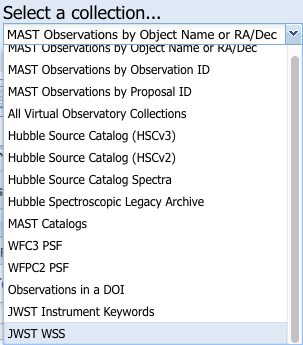Page History
| Excerpt | ||
|---|---|---|
| ||
This article summarizes the variety of JWST data products that supplement the science data. |
| Panel | ||||||||
|---|---|---|---|---|---|---|---|---|
| ||||||||
The products described here will facilitate your understanding of science data quality, or of products that were used in the course of calibrating the science data. This article will help you distinguish between these supplemental products vs. those intended for science analysis. On this page...
|
Auxiliary Data
The term Auxiliary corresponds to a specific category of data products stored in MAST. For JWST, these include certain products used to enable the observations, products generated during the course of calibration, or contemporaneous guide-star products. Other categories of supplemental products, such as preview products and calibration reference files, are described in sections below.
Pre-Observation Products
Some products are generated by the Program Principal Investigator team to enable the proper execution of the observations. These include Preimage files (images used to generate a catalog of sources to align targets in a multi-object field for spectroscopy) and the Micro-shutter array (MSA) definition files for NIRSpec.
Intermediate Calibration Products
Some intermediate data products are created by the JWST calibration pipeline (such as *_segm files). They can be useful for evaluating the quality of the resulting science products or the performance of the pipeline software, and may be helpful for users when deciding whether to re-run the CAL pipeline on their own compute platform. These products are information-only and are not useful for science analysis.
Guide Star Data
Science data (as opposed to internal calibration data) are obtained under some form of guiding to keep the telescope alignment and roll stable during the exposures. Guide-stars are observed contemporaneously with the Fine Guidance Sensor (FGS) for this purpose. Guiding data from the FGS are associated with science data during processing, and are presented alongside Level-2 data products for the instrument (or instruments, if there were parallel observations) that obtained data during that alignment. In the MAST Portal you can see these products in the Download Basket.
Guide-star data can be identified by the string gs- in the file name. There are multiple types of guide-star data, and a few levels of processing. These files contain one of the following substrings in the file name:
_gs-id_N_– Guide-star identification image(s)_gs-acqN_– Guide-star acquisition image(s)_gs-track_– Guide-star track image series_gs-guide_– Guide-star guiding image series
Where N is an integer running from 1 to the number of such products. Only the track and guide files are likely to be useful for end-users to assess science data quality. See Guide Star Data Products for details.
| Anchor | ||||
|---|---|---|---|---|
|
Preview products are generated for most science files primarily to give MAST Portal users a way to visualize what the Observations may contain. However, they may also be useful to end users to understand the quality or applicability of the selected data for their scientific purpose. These products are in either PNG or JPG format, and are down-sampled to be fairly small compared to the original science products. Some of them, such as timeseries plots, can be visualized with advanced Portal tools. See the Data Browsing Tools chapter of the MAST Portal Guide for details.
Wavefront Sensing Data
This data can be accessed under 'JWST WSS' in the 'Select a collection...' menu (see menu at right).
WSS sensing data consist of Optical Path Difference (OPD) files. These give measurements of the alignment state of JWST’s mirrors as a function of time. Each OPD file is a 2D map representing the primary mirror, with numerical values at each location representing the computed misalignment error in the wavefront; that is, the difference between the measured light path and the ideal as-designed light path through the telescope.
You can use OPD files in software such as WebbPSF to compute models for the point spread function of the telescope and any instrument aperture as a function of time. That may help you understand the image quality of observations you analyze.
| Anchor | ||||
|---|---|---|---|---|
|
Various files are constructed off-line and used by the calibration pipeline to remove instrumental signatures from the science data; remove astrophysical background; apply astrometric, wavelength, radiometric, and other calibrations; to extract spectra; and so on. See the CAL pipeline Reference File Information page for details.
